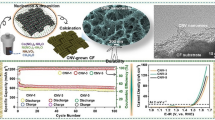Abstract
In this study, we modified carbon nanotubes (CNTs) by grafting with poly(ethylene glycol) (PEG) using the “grafting to” method. The PEG-grafted CNT (CNT-g-PEG) was cast on indium tin oxide (ITO) electrode to investigate the electrocatalytic activity of CNT to the redox reactions of the Fe(CN) 3−/4−6 as a probe using cyclic voltammetry and electrochemical impedance spectroscopy. The electrocatalytic activity of CNT was correlated with CNT dispersion in the cast film on ITO as a function of pH of aqueous solution from which the film was cast. The CNT dispersions in aqueous solutions of different pH and in the cast films were examined by visual observation and zeta potential, scanning electron microscopy and transmission electron microscopy, respectively. At a pH in the range of 3–11 at which ITO electrode was modified, two functionalized CNT (fCNT and CNT-g-PEG) were both found to electrocatalyze the redox reactions of the Fe(CN) 3−/4−6 probe and the PEG grafts in CNT-g-PEG could help CNT adhere to the electrode to obtain durable modified electrode. The more uniform CNT dispersions in aqueous solutions and in the cast films appeared to have greater electrocatalytic acitivity.










Similar content being viewed by others
References
Shieh YT, Liu GL, Wu HH, Lee CC (2007) Effects of polarity and pH on the solubility of acid-treated carbon nanotubes in different media. Carbon 45:1880–1890
Chattopadhyay J, Cortez FJ, Chakraborty S, Slater NKH, Billups WE (2000) Synthesis of water-soluble PEGylated single-walled carbon nanotubes. Chem Mater 18:5864–5868
Kalinina I, Worsley K, Lugo C, Mandal S, Bekyarova E, Haddon RC (2011) Synthesis, dispersion, and viscosity of poly(ethylene glycol)-functionalized water-soluble single-walled carbon nanotubes. Chem Mater 23:1246–1253
Jia F, Shan C, Li F, Niu L (2008) Carbon nanotube/gold nanoparticles/polyethylenimine-functionalized ionic liquid thin film composites for glucose biosensing. Biosens Bioelectron 24:945–950
Chicharro M, Arribas AS, Moreno M, Bermejo E, Zapardiel A (2007) Comparative study of multi walled carbon nanotubes-based electrodes in micellar media and their application to micellar electrokinetic capillary chromatography. Talanta 74:376–386
Rubianes MD, Rivas GA (2007) Dispersion of multi-wall carbon nanotubes in polyethylenimine: a new alternative for preparing electrochemical sensors. Electrochem Commun 9:480–484
Wen Y, Wu H, Chen S, Lu Y, Shen H, Jia N (2009) Direct electrochemistry and electrocatalysis of hemoglobin immobilized in poly(ethylene glycol) grafted multi-walled carbon nanotubes. Electrochimica Acta 54:7078–7084
Yang ST, Wang H, Meziani MJ, Liu Y, Wang X, Sun YP (2009) Biodefunctionalization of functionalized single-walled carbon nanotubes in mice. Biomacromolecules 10:2009–2012
Jung DH, Ko YK, Jung HT (2004) Aggregation behavior of chemically attached poly(ethylene glycol) to single-walled carbon nanotubes (SWNTs) ropes. Materials Sci Eng C 24:117–121
Niu L, Luo Y, Li Z (2007) A highly selective chemical gas sensor based on functionalization of multi-walled carbon nanotubes with poly(ethylene glycol). Sensors Actuators B: 361–367.
Zhao W, Song C, Pehrsson PE (2002) Water-soluble and optically pH-sensitive single-walled carbon nanotubes. J Am Chem Soc 124:12418–12419
Liu A, Watanabe T, Honma I, Wang J, Zhou H (2006) Effect of solution pH and ionic strength on the stability of poly(acrylic acid)-encapsulated multiwalled carbon nanotubes aqueous dispersion and its application for NADH sensor. Biosens Bioelectron 22:694–699
Liang R, Peng H, Qiu J (2008) Fabrication, characterization, and application of potentiometric immunosensor based on biocompatible and controllable three-dimensional porous chitosan membranes. J Colloid Interface Sci 320:125–131
Acknowledgments
We thank National Science Council of Taiwan for financial support for this work under the contract NSC 98-2221-E-390-002-MY3.
Author information
Authors and Affiliations
Corresponding author
Rights and permissions
About this article
Cite this article
Shieh, YT., Yu, TY., Wang, TL. et al. Effects of pH on electrocatalytic activity of functionalized carbon nanotubes. Colloid Polym Sci 290, 1–9 (2012). https://doi.org/10.1007/s00396-011-2516-7
Received:
Revised:
Accepted:
Published:
Issue Date:
DOI: https://doi.org/10.1007/s00396-011-2516-7




